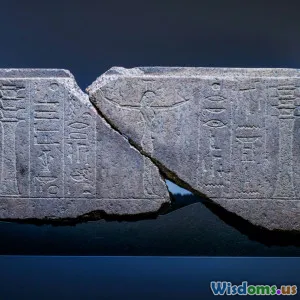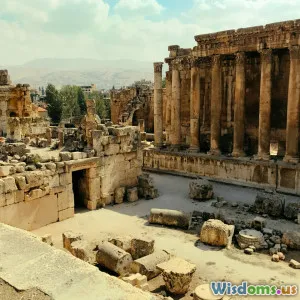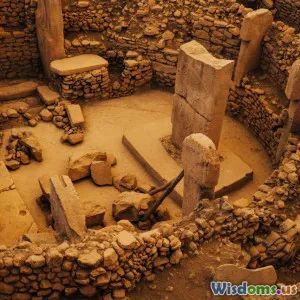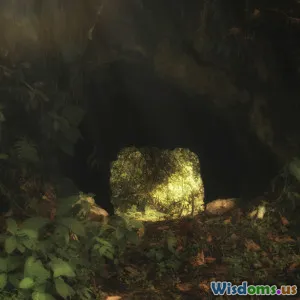
How To Identify Genuine Atlantean Artifacts Like An Expert
16 min read Explore expert techniques and real examples to distinguish genuine Atlantean artifacts from imitations, delving into archaeology, material science, and mythology for enthralling investigation. (0 Reviews)
How To Identify Genuine Atlantean Artifacts Like An Expert
Atlantis! Just the name evokes images of sunken palaces, advanced technology, and lost mysteries waiting to surface again. The allure of Atlantean artifacts captivates collectors, scholars, and dreamers alike. Yet, the field of Atlantean antiquities is rife with imitation, speculation, and mystery. How does one separate myth from authentic history? This article guides you through expert methods, scientific approaches, and insightful examples to help you uncover the secrets of genuine Atlantean relics with confidence—just like a seasoned pro.
Table of Contents
- Introduction: The Allure and Challenge of Atlantean Artifacts
- Understanding Authenticity: Fact Versus Fiction
- Provenance: Tracing the Artifact's Journey
- Material Matters: Scientific Analysis
- Iconography and Design: The Language of Artifacts
- Context Matters: Archaeological Evidence
- Famous Cases: Real and Imagined Atlantian Artifacts
- Debunking Common Myths and Indicators of Fakes
- Expert Tools and Resources
- Conclusion: How to Put Knowledge Into Practice
Introduction: The Allure and Challenge of Atlantean Artifacts
Since Plato’s ancient texts introduced Atlantis in 360 BCE, the lost city has become synonymous with mystery, advanced civilization, and unending human curiosity. Over centuries, countless treasures—ornate jewelry, mysterious stone tablets, and even mechanical devices—have been presented as ‘genuine’ Atlantean discoveries. But given that Atlantis itself remains undiscovered, sifting legend from evidence is as challenging as the quest for Atlantis itself.
Consider the case of the so-called Orichalcum ingots alleged to be Atlantean—a find that thrilled archaeologists in 2015 near Sicily. As enthusiasts and experts alike engage in the search, the question grows: can you really tell if an artifact is authentically Atlantean? You can—if you know what to look for, and how to separate fact from fabrication.
Understanding Authenticity: Fact Versus Fiction
Before plunging into techniques, it’s crucial to realize that the field of Atlantean artifact identification is complicated by myth. No officially recognized "Atlantean civilization" has ever been discovered by mainstream science. However, artifacts have surfaced purporting to bear "Atlantean" origins—from rare metals to ancient texts. Some of these are rooted in misattributions from Minoan or Egyptian sources, while others are outright modern inventions.
Analogy: Imagine an enthusiast claiming a modern ceramic as Roman, simply because of superficial resemblance and an elaborate backstory. In the same way, false Atlantean artifacts frequently mimic genuine ancient styles but lack the true cultural and historical context. Authorities such as Dr. Kenneth Feder, author of Frauds, Myths, and Mysteries: Science and Pseudoscience in Archaeology, urge vigilance: “If it seems too incredible, it probably is.”
Hallmarks of Genuine Artifacts
- Documented context of discovery
- Correlation with known ancient materials and techniques
- Confirmed age by scientific methods
- Absence of anachronisms (out-of-place materials, modern tool marks, etc.)
Fake Atlantean items often derive their backstories from popular books, such as Ignatius Donnelly’s 19th-century treatise or contemporary conspiracy theories, rather than verified archaeological practice.
Provenance: Tracing the Artifact's Journey
Any expert, whether in antiquities or forensics, will tell you: provenance—the documented history of an item's discovery and ownership—is a crucial indicator of authenticity. Genuine artifacts are most valuable when their chain of custody can be clearly traced back to their archaeological context.
Key Elements of Provenance
- Discovery Record: Is there a site report or credible witness account? For example, the Orichalcum ingots found in a shipwreck near Sicily in 2015 were accompanied by official maritime archaeological documentation, giving them far more credibility.
- Ownership Timeline: Can the object’s movement through private hands, collections, or museums be reconstructed? The famous Phaistos Disk, although believed by some to have Atlantean links, is reliably traced to a 1908 excavation in Crete, lending legitimacy to its source.
- Documentation from Reputable Institutions: Artifacts affiliated with established museums or academic bodies are more likely to withstand scrutiny.
Case Study: The so-called "Atlantean Crystal Skulls" widely marketed in the 20th century were later found to have dubious provenances, typically originating from gem dealers rather than archaeological digs.
Red Flags
- Missing or fabricated excavation records
- Suspiciously recent emergence of "ancient" objects
- Gaps in ownership
Material Matters: Scientific Analysis
Expert identification often depends on modern analytical techniques that strip away the mystique to reveal hard facts. Real artifacts must withstand powerful scrutiny:
X-Ray Fluorescence (XRF) Spectroscopy
Used for non-destructive material analysis, XRF can determine the elemental make-up of metals and ceramics. When Orichalcum ingots were analyzed, for instance, they showed high levels of copper, zinc, and lead—consistent with a rare ancient alloy referenced in texts but not unique enough to prove an Atlantean origin alone.
Carbon Dating and Thermoluminescence
For organic substances, radiocarbon dating can estimate an artifact's age to within years or centuries. Thermoluminescence dating, useful on ceramics, reveals the last time the object was heated. No verifiable Atlantean artifact has yet yielded a unique date beyond known civilizations, but scientific dating does weed out most modern fakes.
Microscopic Tool Analysis
How was the artifact made? Genuine ancient items bear the telltale marks of period-appropriate tools. Electron microscopes can detect micro-scratches, revealing whether stone was worked with copper chisels, iron tools, or modern steel blades. For example, many "Atlantean" crystals exhibit rotary tool marks—evidence of recent, not prehistoric, fabrication.
Expert Insight: Dr. Bettina Schmitz, a German archaeometrist, says: “Most alleged Atlantean objects show anachronistic techniques—modern glues, abrasives, or polishing marks invisible to the naked eye.”
Iconography and Design: The Language of Artifacts
Symbols and decorative motifs on artifacts can serve as cultural signatures. Seasoned researchers compare these against known histories. Is the iconography consistent with the supposed era? Does it blend themes from verifiable civilizations, or does it stand apart in a way that might signal invention?
Studying the Symbols
For example, several "Atlantean" statuettes on the market copy Egyptian, Phoenician, or Minoan motifs, aiming to piggyback on the real aura of Mediterranean Bronze Age cultures. However, unique or fantastical designs—no matter how appealing—are rarely supported by real-world evidence.
- Known civilizational crossovers? The discovery of Atlantis remains a theory, but if such a site existed, it is logical to expect overlap with other Mediterranean cultures—a sudden, isolated technological leap might itself be a warning sign.
- Inscriptions: Are the scripts used recognizable (Linear A, B, hieroglyphics)? Invented scripts lacking in legitimate scholarly reference typically indicate a modern creation.
Quote: As Dr. Dominique Garcia, French prehistorian, asserts, “True artifacts are woven into the weave of regional artistic tradition—fakes often confound or exaggerate to entice the modern audience.”
Real Example: The Antikythera mechanism, once suspected to be Atlantean, features Greek inscriptions with unmistakable ties to Hellenistic technology. Its precise design verification and cultural rootedness cement its real, albeit not Atlantean, status.
Context Matters: Archaeological Evidence
Artifacts do not appear in isolation. Their discovery alongside datable, well-contextualized material offers invaluable clues.
- Site Context: Genuine finds are part of larger assemblages—buried with ceramics, remains, or tools of established age and style.
- Geological Placement: Are the sediment layers where the artifact was found consistent with accepted chronology?
- Environmental Traces: Pollen grains, residues, and wear patterns tell stories about when and how an item was used.
Comparing Contexts: Atlantis versus Established Sites
For example, the palace at Knossos (Minoan, Crete) yielded vases, frescoes, and technology directly tied to its time period—supported by evidence at every layer. In contrast, so-called "Atlantis stones" sold online typically lack any archaeological context at all.
Pro Tip: Always beware the "out-of-place artifact." Without supporting finds, even intriguing objects lose their credibility.
Famous Cases: Real and Imagined Atlantis Artifacts
Some artifacts continue to spark controversy, embodying the complexities of Atlantean authentication.
Case 1: Orichalcum Ingots
In 2015, Italian archaeologists recovered 39 ingots from a shipwreck near Sicily, made of a copper-zinc-brass alloy described in Plato’s Atlantis narrative. Tests demonstrate a Bronze Age composition, yet whether they are "Atlantean" or simply ancient trade goods remains debated—underscoring how close and yet so far we are from true provenance.
Case 2: Crystal Skulls
Popularized by explorers and mystics, various “Atlantean” crystal skulls have surfaced in museums and private collections. Testing at the Smithsonian and British Museum revealed use of modern rotary grinding tools—decisively late 19th to 20th century, with no sign of ancient manufacture.
Case 3: Bimini Road
Off the coast of Bimini in the Bahamas lies a remarkable underwater formation, dubbed “Bimini Road,” that some claim to be an Atlantean causeway. However, investigations by geologists (e.g., Eugene Shinn) have shown these are naturally formed beachrock structures, not the handiwork of ancient engineers.
Case 4: The Phaistos Disk
Unearthed in Crete in 1908, this stamped clay disk with mysterious symbols has invoked Atlantis in numerous speculative theories. Linguists and archaeologists agree on its Minoan descent—possible ties to Atlantis remain poetic rather than proven.
Debunking Common Myths and Indicators of Fakes
Top Myths
- Advanced Technology as Proof: Gadgets or out-of-time mechanisms are sometimes held up as "Atlantean," but subsequent analysis almost always reveals plausible local development or modern hoaxery.
- Mysterious Materials: Claims of unknown alloys (like orichalcum) often conflate real ancient metals with imaginative elements; extensive material testing has yet to turn up a truly unknown substance.
- Uncoded Scripts and Odd Languages: Outlandish inscriptions, unlike any known script, often point to inventive sellers instead of ancient linguists.
Recognizing Fakes
- Overly polished surfaces
- Modern adhesives or resins
- Lack of wear in joints or decorative recesses
- Perfect symmetry (abhorrent in hand-fashioned setups)
- Too-good-to-be-true legends or stories
Expert Insight: “Fakes thrive on ambiguity. Hard science and context checkmate speculation,” says Dr. Susan B. Hoover, artifact authentication specialist.
Buyer Beware: The Atlantis Market
Online and even in brick-and-mortar shops, purported “Atlantis” artifacts abound. These often come with dubious backstories and certifications from unofficial “Atlantean Societies.” No legitimate museum, university, or professional society currently certifies any artifact as Atlantean.
Expert Tools and Resources
Ready to put your expertise to use? Here’s where experts turn to support or debunk artifact claims:
- Research Databases: Look up related archaeological publications on platforms like JSTOR, ScienceDirect, and Academia.edu.
- Museum Consultation: Renowned institutions, such as the British Museum and the National Museum of Archaeology in Athens, offer public records and, occasionally, artifact evaluation days.
- Professional Organizations: Join associations for archaeology enthusiasts (e.g., Archaeological Institute of America), which frequently host lectures and workshops.
- Material Analysis Labs: Collaborate with specialists for XRF, radiometric, and microscopic analysis.
- Scholarly Catalogues: Cross reference object forms with those documented in established histories of the Mediterranean and Near Eastern worlds.
Pro Tip: If in doubt, consult a trained archaeologist or authentication expert. As with any rare collectible, skepticism protects both your finances and your reputation.
Conclusion: How to Put Knowledge Into Practice
Becoming an expert in identifying authentic Atlantean artifacts doesn’t require a degree in archaeology, but it does demand methodical inquiry, healthy skepticism, and the willingness to seek expert help. While tales of Atlantis will forever tempt the imagination, scientific rigor, provenance, and context are your steadfast aids in uncovering the truth.
Final Checklist for the Aspiring Artifact Expert:
- Insist on verifiable provenance
- Seek scientific material authentication
- Cross-check iconography with scholarly reference
- Evaluate site and context evidence
- Reject objects without credible discovery and dating records
- Beware extraordinary claims—require extraordinary proof
As you traverse the fascinating world of Atlantis artifacts, remember: every great discovery starts not with certainty but with bold, careful questions and the unfailing pursuit of evidence. The next time you encounter an “Atlantean” artifact, you’ll have the insight and tools to look beyond the legend and see the artifact’s true story.
Further Reading:
- Frauds, Myths, and Mysteries by Kenneth Feder
- The Atlantis Encyclopedia by Frank Joseph
- Atlantis: The Antediluvian World by Ignatius Donnelly (for historical context, not fact)
Uncover the truth, separate fact from fantasy—and enjoy the adventure so many before have embraced. Atlantis may yet lie beneath the waves, but the real treasures are the skills and insights you gain on the quest to authenticate its legacy.
Rate the Post
User Reviews
Popular Posts



















